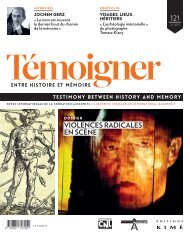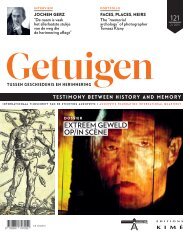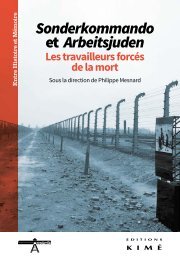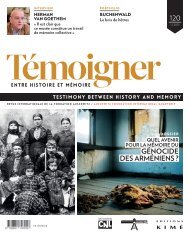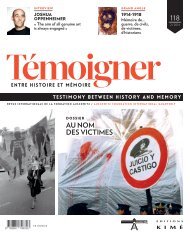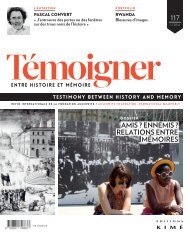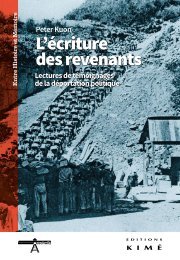Revue : Témoigner entre histoire et mémoire - n° 119 (décembre 2014) : Dossier : Il y a 70 ans, Auschwitz. Retour sur Primo Levi
27 janvier 1945. Il y a 70 ans les premiers soldats de l’Armée rouge pénétraient dans le camp d’Auschwitz marquant définitivement ce que l’on pourrait appeler sa « libération », bien qu’Auschwitz n’ait été, pas plus qu’aucun autre camp nazi, un objectif prioritaire pour aucune des forces alliées. Primo Levi faisait partie des quelques rescapés qui, échappant aux évacuations forcées, étaient restés cachés à Auschwitz. Juif, déporté, chimiste, témoin, écrivain, retour sur cette personnalité complexe, sur son ascension vers ce qu’il a appelé le « rescapé professionnel », sur son œuvre. Sur ce que les mots « résistance », « engagement » ont signifié pour lui.
27 janvier 1945. Il y a 70 ans les premiers soldats de l’Armée rouge pénétraient dans le camp d’Auschwitz marquant définitivement ce que l’on pourrait appeler sa « libération », bien qu’Auschwitz n’ait été, pas plus qu’aucun autre camp nazi, un objectif prioritaire pour aucune des forces alliées. Primo Levi faisait partie des quelques rescapés qui, échappant aux évacuations forcées, étaient restés cachés à Auschwitz. Juif, déporté, chimiste, témoin, écrivain, retour sur cette personnalité complexe, sur son ascension vers ce qu’il a appelé le « rescapé professionnel », sur son œuvre. Sur ce que les mots « résistance », « engagement » ont signifié pour lui.
- TAGS
- primo-levi
- auschwitz
Create successful ePaper yourself
Turn your PDF publications into a flip-book with our unique Google optimized e-Paper software.
Chroniques<br />
Logbook<br />
REVEALING THE IMAGE,<br />
REVEALING TRUTH<br />
Daniel Hernández-Salazar’s visual memory<br />
of the genocide in Guatemala<br />
EXHIBITION From the modernity of the<br />
Angels. After Klee’s painting, which is now<br />
b<strong>et</strong>ter known through Walter Benjamin’s<br />
commentary than by itself, and after Wim<br />
Wender’s Wings of desire, we now have<br />
to make way for this Angel which comes<br />
from Guatemala to point out the violence<br />
endured by the Maya people.<br />
AInterview by Anneleen Spiessens & Janiv Stamberger<br />
During Guatemala’s 36-year Civil War (1960-<br />
1996), the military government engaged<br />
in a brutal “counterin<strong>sur</strong>gency” campaign<br />
against all forms of opposition. The rural<br />
Mayan population especially was singled out as the<br />
government accused them of siding with revolutionary<br />
armed groups. In the 1980s, the army and its paramilitary<br />
groups applied a “scorched earth” policy, resulting<br />
not only in the systematic assassination and relocation<br />
of indigenous communities, but also in the destruction<br />
of entire villages and sacred places. Guatemala’s<br />
Truth Commission (Comisión para el Esclarecimiento<br />
Histórico) reported in 1999 that 83% of the 200,000<br />
victims of the war were Mayan and concluded that the<br />
State violence against the Ixil Maya people amounted<br />
to “acts of genocide”. A peace accord was signed in<br />
1996, but this has not resulted in the construction of<br />
a collective and inclusive memory of the genocide in<br />
Guatemala, nor has it succeeded in providing justice for<br />
the victims. In May 2013 human rights organizations<br />
hailed the “historical” conviction of Efraín Ríos Montt,<br />
Chief of State at the height of the military campaign<br />
(1982-1983), for genocide and crimes against humanity.<br />
A few days later, however, the sentence was revoked<br />
by the Constitutional Court on procedural grounds.<br />
© Anneleen Spiessens<br />
With his pictures of the exhumations and protests,<br />
photographer and human rights activist Daniel<br />
Hernández-Salazar brings the plight of the <strong>sur</strong>vivors<br />
and the victims’ families into the public eye, endorsing<br />
their call for recognition and social justice. His picture<br />
depicting a mestizo angel with wings made from the<br />
scapulae bones of one of the nameless victims of the<br />
genocide has become an iconic image in Guatemala.<br />
The artist’s work is currently on display at Kazerne<br />
Dossin.<br />
Daniel Hernández-Salazar, can you tell us about your<br />
professional background and how you came to be a photographer<br />
Daniel Hernández-Salazar: Taking photographs has<br />
always been a passion for me. I started taking pictures<br />
from a very young age. Nevertheless, I decided to study<br />
BIOGRAPHY<br />
i<br />
1956 / born<br />
1974 / starts studying Architecture<br />
1978 / starts his career in Fine Art<br />
Photography<br />
1980s / works for several international news<br />
agencies (Reuters, AFP, Associated Press)<br />
and starts documenting the Civil War in<br />
Guatemala<br />
1993 / receives a replica of the Nobel Peace<br />
Prize Medal from Rigoberta Menchú Tum<br />
1998 / his polyptych Esclarecimiento/<br />
Clarification appears on the cover of<br />
Guatemala: Never Again, the final report of<br />
Bishop Juan José Gerardi’s “Recovery of<br />
Historical Memory” project (REMHI)<br />
1998 / is awarded the Jonathan Mann<br />
Humanitas Award for his artistic work on<br />
human rights issues<br />
2004 / publishes his first anthology,<br />
Guatamala, Memoria de un Ángel (Kage<br />
Shobo)<br />
2005 / is decorated and made Knight of the<br />
Order of Arts and L<strong>et</strong>ters by the Ministry of<br />
Culture and Communications of France<br />
2007 / publishes Para que todos lo sepan/<br />
So That All Shall Know (University of Texas<br />
Press)<br />
<strong>2014</strong> / presents two exhibitions in Belgium.<br />
architecture, which actually influenced the way I think<br />
and perceive things – and the way I make photographs.<br />
There I learned about composition, light and colour.<br />
When a major earthquake shook Guatemala in 1976,<br />
I began working on the reconstruction of the cathedral<br />
of Guatemala City. I was hired as a draftsman to<br />
outline the reconstruction process but also began to<br />
take pictures of the project. That was the beginning of<br />
my career as a professional photographer. I continued<br />
studying architecture for several years while working<br />
as a photographer but eventually decided not to<br />
continue my studies and to focus on my photography<br />
instead.<br />
At what point in time did you make the tr<strong>ans</strong>ition from<br />
being an architectural photographer to a chronicler of<br />
Mayan culture and especially of the darker chapters of<br />
Guatemalan history, namely the genocide and its effect<br />
on Guatemalan soci<strong>et</strong>y<br />
Daniel Hernández-Salazar: I have always been very sensitive<br />
and aware of the power of communication and<br />
of the role and influence media have on soci<strong>et</strong>y. That<br />
became more clear when I started working as a photojournalist<br />
for newspapers in Guatemala, and later as<br />
a correspondent for press agencies. The period when<br />
I worked for Associated Press coincided with the last<br />
years of the war. Being a journalist at that time helped<br />
me to decide which direction I wanted to take with<br />
my work. I have always been attuned to social issues,<br />
but working with the press helped me focus the way<br />
I wanted to commit myself – and understand how to<br />
use photography as an instrument, as a tool to convey<br />
a certain message to make people aware of important<br />
events taking place. I understood the importance of<br />
leaving traces, graphic documents of what happened.<br />
The exhibition in Kazerne Dossin seems to be very<br />
different from the one in Galerie Verbeeck-Van Dyck in<br />
Antwerp when it comes to “documenting” the genocide.<br />
Daniel Hernández-Salazar: Indeed, the exhibition in<br />
Kazerne Dossin focuses more on the photojournalistic<br />
documentary work I have done and continue to<br />
do. It reveals my interest in preserving what I would<br />
call a “visual memory” of the genocide. The exhibition<br />
in Antwerp shows another side of my work. I used a<br />
different m<strong>et</strong>hod to create the pieces I presented at<br />
Galerie Verbeeck-Van Dyck to convey emotions and<br />
make them more personal. I cut the photos in pieces<br />
and afterwards reconstruct them with nails or scotch<br />
tape to represent rupture and pain. Another layer is<br />
added to the truth-value of the pictures, a more m<strong>et</strong>aphorical<br />
and subjective one that refers to universal<br />
human themes like life, death or love, and tr<strong>ans</strong>mits my<br />
artistic intention. During my career as a photographer,<br />
I have tried to combine both the need of communicating<br />
a message to the outside world and the need of<br />
expressing myself through my work. That is still true<br />
today, but I am more conscious of it now. I believe both<br />
approaches work, for me and for the public.<br />
How do you conceive of the role of art – of your art – in<br />
soci<strong>et</strong>y Should all art “work”<br />
Daniel Hernández-Salazar: Well, I believe art has a specific<br />
function in soci<strong>et</strong>y. Some people think art is just for<br />
fun or to decorate a house: “the painting or photograph<br />
should match the rug or the curtains”. I do not agree<br />
l l l<br />
10 <strong>Témoigner</strong> <strong>entre</strong> <strong>histoire</strong> <strong>et</strong> <strong>mémoire</strong> – <strong>n°</strong><strong>119</strong> / Décembre <strong>2014</strong> Testimony B<strong>et</strong>ween History and Memory – <strong>n°</strong><strong>119</strong> / December <strong>2014</strong><br />
11



